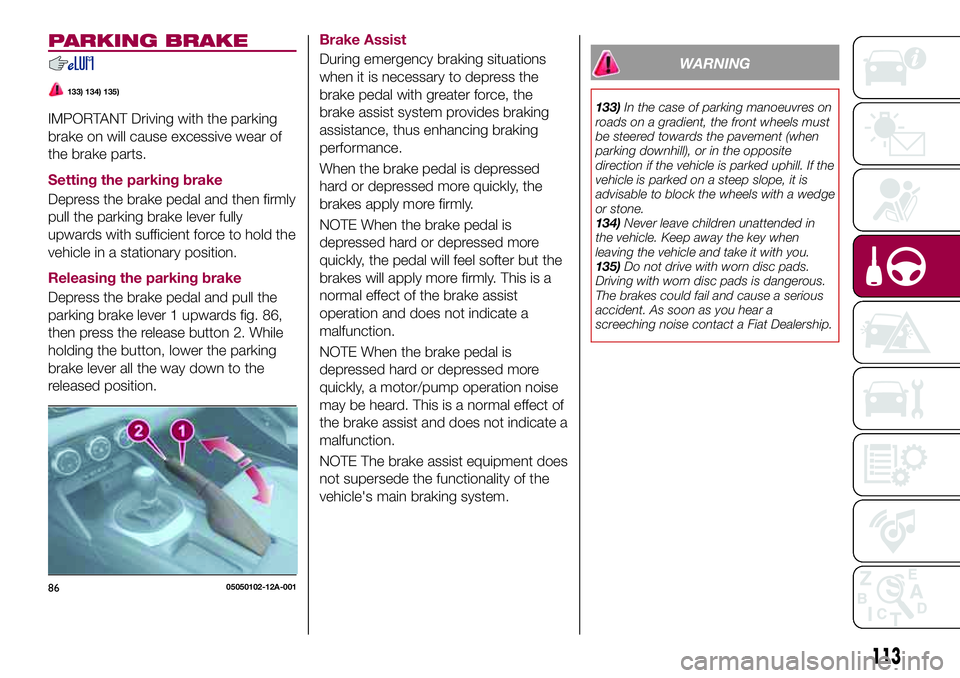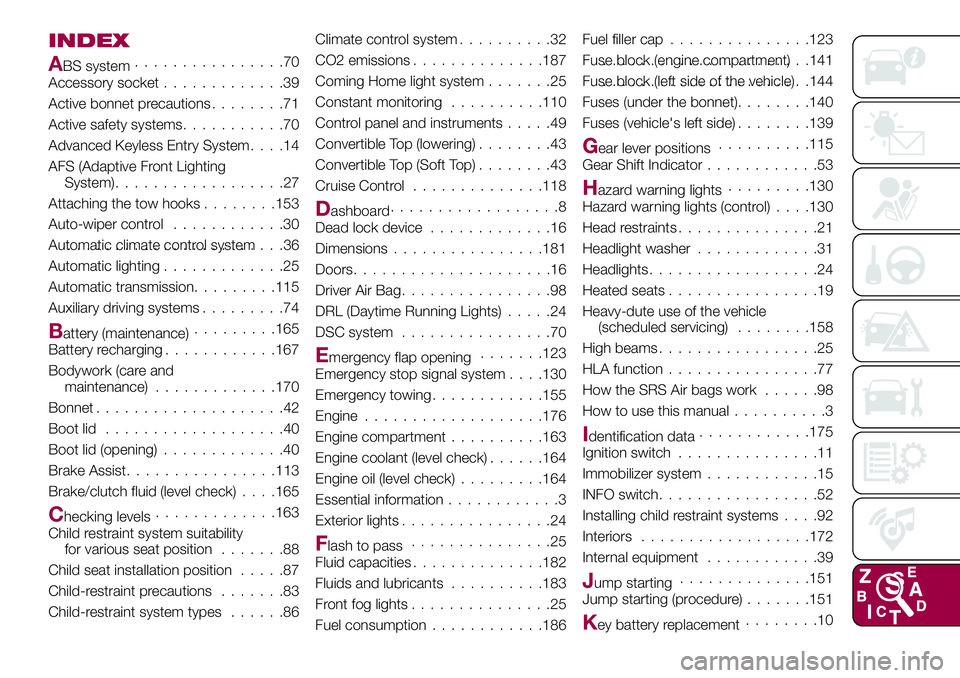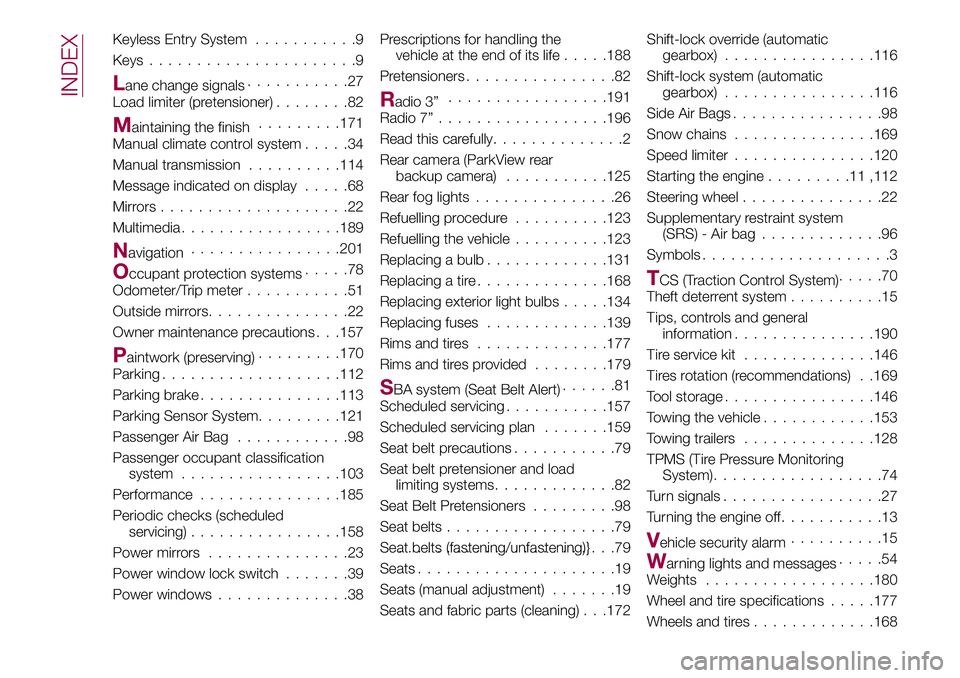key FIAT 124 SPIDER 2018 Owner handbook (in English)
[x] Cancel search | Manufacturer: FIAT, Model Year: 2018, Model line: 124 SPIDER, Model: FIAT 124 SPIDER 2018Pages: 220, PDF Size: 3.18 MB
Page 114 of 220

STARTING THE
ENGINE
130) 131) 132)
24)
Before starting the engine, adjust the
seat, the interior rear view mirrors, the
door mirrors and fasten the seat belt
correctly.
Never press the accelerator pedal for
starting the engine.
For starting procedure see “Starting the
engine” in “Getting to know your
vehicle” chapter.
STOPPING THE ENGINE
Proceed as follows:
park the car in a position that is not
dangerous for oncoming traffic; engage
a gear (versions with manual
transmission) or position the gear lever
to P (Parking) (versions with automatic
transmission);
turn the ignition device to STOP with
the engine idling.
WARNING
130)It is dangerous to run the engine in
enclosed areas. The engine takes in
oxygen and releases carbon dioxide,
carbon monoxide and other toxic gases.131)The brake servo is not active until the
engine is started, so you would need to
apply much more force than usual to the
brake pedal.
132)Do not start the engine by pushing,
towing or driving downhill. These
manoeuvres may damage the catalytic
converter.
IMPORTANT
24)A quick burst on the accelerator before
turning off the engine serves absolutely no
practical purpose; it wastes fuel and is
damaging for the engine.
PARKING
Keep away the key when leaving the
vehicle and take it with you.
When parking and leaving the vehicle,
proceed as follows:
engage a gear (first gear if facing
uphill or reverse if facing downhill) and
leave the wheels turned;
stop the engine and engage the
handbrake.
Block the wheels with a wedge or a
stone if the car is parked on a steep
slope.
On versions equipped with automatic
transmission, before releasing the brake
pedal, wait for letter P to be displayed.
IMPORTANT NEVER leave the vehicle
with the gearbox in neutral (or, on
versions equipped with automatic
transmission, before placing the gear
lever at P).
112
STARTING AND OPERATING
Page 115 of 220

PARKING BRAKE
133) 134) 135)
IMPORTANT Driving with the parking
brake on will cause excessive wear of
the brake parts.
Setting the parking brake
Depress the brake pedal and then firmly
pull the parking brake lever fully
upwards with sufficient force to hold the
vehicle in a stationary position.
Releasing the parking brake
Depress the brake pedal and pull the
parking brake lever 1 upwards fig. 86,
then press the release button 2. While
holding the button, lower the parking
brake lever all the way down to the
released position.Brake Assist
During emergency braking situations
when it is necessary to depress the
brake pedal with greater force, the
brake assist system provides braking
assistance, thus enhancing braking
performance.
When the brake pedal is depressed
hard or depressed more quickly, the
brakes apply more firmly.
NOTE When the brake pedal is
depressed hard or depressed more
quickly, the pedal will feel softer but the
brakes will apply more firmly. This is a
normal effect of the brake assist
operation and does not indicate a
malfunction.
NOTE When the brake pedal is
depressed hard or depressed more
quickly, a motor/pump operation noise
may be heard. This is a normal effect of
the brake assist and does not indicate a
malfunction.
NOTE The brake assist equipment does
not supersede the functionality of the
vehicle's main braking system.
WARNING
133)In the case of parking manoeuvres on
roads on a gradient, the front wheels must
be steered towards the pavement (when
parking downhill), or in the opposite
direction if the vehicle is parked uphill. If the
vehicle is parked on a steep slope, it is
advisable to block the wheels with a wedge
or stone.
134)Never leave children unattended in
the vehicle. Keep away the key when
leaving the vehicle and take it with you.
135)Do not drive with worn disc pads.
Driving with worn disc pads is dangerous.
The brakes could fail and cause a serious
accident. As soon as you hear a
screeching noise contact a Fiat Dealership.
8605050102-12A-001
113
Page 205 of 220

map. Highlighted arrows represent the
lanes and direction you need to take.
Junction view: if you are
approaching a motorway exit or a
complex intersection and the needed
information exists, the map is replaced
with a 3D view of the junction.
Motorway exit services: you may
need a petrol station or a restaurant
during your journey. This feature
displays a new button on the map
when you are driving on motorways.
Select this Open button to open a panel
with the details of the next few exits or
service stations.
Elements of the active route: the
navigation system shows the route in
the following way.
SELECTING THE DESTINATION OF
A ROUTE
Entering an address
To enter an address as the destination,
do as follows:
Selectafter selectingon the
MAP screen.
SelectFind Address. By default, the
navigation system proposes the country
and town where you are. If needed,
selectCountry, enter the first few
letters of the country name on the
keyboard, and select one country from
the list of results.
If needed, select a new town: select
Townand Start entering the name of
the town on the keyboard. Find the
town you need: the most likely town
name is always shown in the input field.
To accept it, select. If the desired name
does not show up, the names that
match the string appear in a list after
entering a couple of characters (to open
the list of results before it appears
automatically, select
and select
the town from the list).
Enter the street name: select
name of the town on the keyboard.
Find the street you need: the most likely
street name is always shown in the
input field. To accept it, select. If the
desired name does not show up, the
names that match the string appear in a
list after entering a couple of characters
(to open the list of results before it
appears automatically, select
and
select the street from the list).
Enter the house number: select
House Numberthen enter the house
number on the keyboard (to enter
letters, selectQWE). Select to finish
entering the address. (If the entered
house number cannot be found, the
midpoint of the street is selected as the
destination.
The selected location is shown on
the map. NavigationStartif is selected,
or after 10 seconds of no user
interaction. By touching the location
displayed on the screen, you can verify
the route. Additionally, the route can be
revised by selecting other options.
Selecting the destination from the
POI
(Point Of Interest)
If the name for a POI (Point Of Interest)
is input, a search candidate list is
displayed.
Proceed as follows:
Selectafter selectingon the
MAP screen.
SelectFind Places.
SelectFilter by Name.
Using the keyboard, enter the name
of the POI (Point Of Interest). After
entering a few letters, select to open
the list of POI with names containing
the entered character sequence.
The selected location is shown on
the map. The system transitions to the
next screen by selectingNavigate To,
or it returns to the previous screen by
selecting the
can change the destination to anywhere
on the map.
203
Page 215 of 220

INDEX
ABS system................70
Accessory socket.............39
Active bonnet precautions........71
Active safety systems...........70
Advanced Keyless Entry System....14
AFS (Adaptive Front Lighting
System)..................27
Attaching the tow hooks........153
Auto-wiper control............30
Automatic climate control system.......................36
Automatic lighting.............25
Automatic transmission.........115
Auxiliary driving systems.........74
Battery (maintenance).........165
Battery recharging............167
Bodywork (care and
maintenance).............170
Bonnet....................42
Boot lid...................40
Boot lid (opening).............40
Brake Assist................113
Brake/clutch fluid (level check). . . .165
Checking levels.............163
Child restraint system suitability
for various seat position.......88
Child seat installation position.....87
Child-restraint precautions.......83
Child-restraint system types......86Climate control system..........32
CO2 emissions..............187
Coming Home light system.......25
Constant monitoring..........110
Control panel and instruments.....49
Convertible Top (lowering)........43
Convertible Top (Soft Top)........43
Cruise Control..............118
Dashboard..................8
Dead lock device.............16
Dimensions................181
Doors.....................16
Driver Air Bag................98
DRL (Daytime Running Lights).....24
DSC system................70
Emergency flap opening.......123
Emergency stop signal system. . . .130
Emergency towing............155
Engine...................176
Engine compartment..........163
Engine coolant (level check)......164
Engine oil (level check).........164
Essential information............3
Exterior lights................24
Flash to pass...............25
Fluid capacities..............182
Fluids and lubricants..........183
Front fog lights...............25
Fuel consumption............186Fuel filler cap...............123
Fuse block (engine compartment)......................141
Fuse block (left side of the vehicle)......................144
Fuses (under the bonnet)........140
Fuses (vehicle's left side)........139
Gear lever positions..........115
Gear Shift Indicator............53
Hazard warning lights.........130
Hazard warning lights (control). . . .130
Head restraints...............21
Headlight washer.............31
Headlights..................24
Heated seats................19
Heavy-dute use of the vehicle
(scheduled servicing)........158
High beams.................25
HLA function................77
How the SRS Air bags work......98
How to use this manual..........3
Identification data............175
Ignition switch...............11
Immobilizer system............15
INFO switch.................52
Installing child restraint systems....92
Interiors..................172
Internal equipment............39
Jump starting..............151
Jump starting (procedure).......151
Key battery replacement........10
Page 216 of 220

Keyless Entry System...........9
Keys......................9
Lane change signals...........27
Load limiter (pretensioner)........82
Maintaining the finish.........171
Manual climate control system.....34
Manual transmission..........114
Message indicated on display.....68
Mirrors....................22
Multimedia.................189
Navigation................201
Occupant protection systems.....78
Odometer/Trip meter...........51
Outside mirrors...............22
Owner maintenance precautions . . .157
Paintwork (preserving).........170
Parking...................112
Parking brake...............113
Parking Sensor System.........121
Passenger Air Bag............98
Passenger occupant classification
system.................103
Performance...............185
Periodic checks (scheduled
servicing)................158
Power mirrors...............23
Power window lock switch.......39
Power windows..............38Prescriptions for handling the
vehicle at the end of its life.....188
Pretensioners................82
Radio 3”.................191
Radio 7”..................196
Read this carefully..............2
Rear camera (ParkView rear
backup camera)...........125
Rear fog lights...............26
Refuelling procedure..........123
Refuelling the vehicle..........123
Replacing a bulb.............131
Replacing a tire..............168
Replacing exterior light bulbs.....134
Replacing fuses.............139
Rims and tires..............177
Rims and tires provided........179
SBA system (Seat Belt Alert)......81
Scheduled servicing...........157
Scheduled servicing plan.......159
Seat belt precautions...........79
Seat belt pretensioner and load
limiting systems.............82
Seat Belt Pretensioners.........98
Seat belts..................79
Seat belts (fastening/unfastening)}.......................79
Seats.....................19
Seats (manual adjustment).......19
Seats and fabric parts (cleaning) . . .172Shift-lock override (automatic
gearbox)................116
Shift-lock system (automatic
gearbox)................116
Side Air Bags................98
Snow chains...............169
Speed limiter...............120
Starting the engine.........11,112
Steering wheel...............22
Supplementary restraint system
(SRS) - Air bag.............96
Symbols....................3
TCS (Traction Control System).....70
Theft deterrent system..........15
Tips, controls and general
information...............190
Tire service kit..............146
Tires rotation (recommendations) . .169
Tool storage................146
Towing the vehicle............153
Towing trailers..............128
TPMS (Tire Pressure Monitoring
System)..................74
Turn signals.................27
Turning the engine off...........13
Vehicle security alarm..........15
Warning lights and messages.....54
Weights..................180
Wheel and tire specifications.....177
Wheels and tires.............168
INDEX